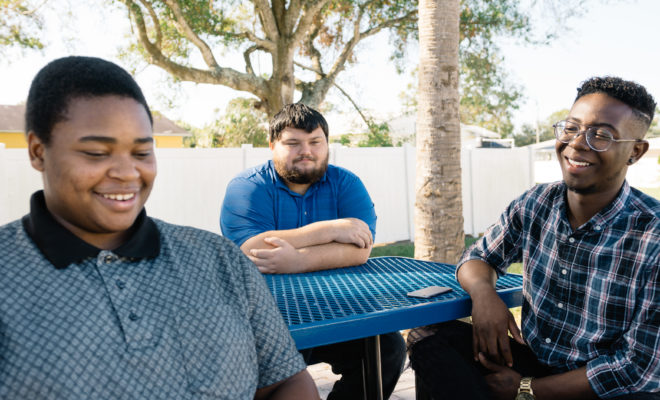
Philanthropy
Gulf Coast Community Foundation’s Unaccompanied Homeless Youth Initiative
By Ryan G. Van Cleave
Whether you see them or not, they’re right here in our community—more than 400 teens and young adults in Sarasota County are homeless and living entirely on their own. They are part of the 6% of the total homeless population that unaccompanied youth represent in the United States. According to the U.S. Department of Housing and Urban Development, on any single night in 2016, there were approximately 35,000 unaccompanied homeless youths throughout the country, with 89% being 18-24 and 11% being under 18.
These unaccompanied youth live in cars, shelters, parks, motels, abandoned buildings, the homes of other people (often called “couch surfing”), and on the streets. Many are running away from abuse, neglect, poverty, or conflict. They don’t have a safe place to return home to. They don’t have a safe place to go. With little or no work experience or life skills, and frequently a lack of education, this often-overlooked group of homeless individuals is on the path to become the next generation of chronically homeless adults in our region.
That’s why Gulf Coast Community Foundation and a collaboration of stakeholders from local government, human services, and philanthropy are working to address gaps in services for homeless youth. The partners include the Charles & Margery Barancik Foundation, Florida Department of Health in Sarasota, Harvest House, More Too Life, Sarasota Family YMCA, The Salvation Army of Sarasota, and Suncoast Partnership to End Homelessness. Together, they’ve implemented three projects that are providing immediate help to homeless youth while also generating data to inform longer-term plans, which include creating emergency shelter space dedicated for youth, targeting behavioral health challenges, and providing education and workforce training.
The initial projects are:
• Youth Action Board: Consisting of teens and young adults with firsthand experience with homelessness, the Youth Action Board empowers these youth to advocate for their own needs more effectively.
• Drop-in Centers: These safe gathering places will provide access to services exclusively for homeless youth in high-need areas. The first center is located in North Sarasota and operated by Harvest House. A location for a second drop-in center in southern Sarasota County is now being explored.
• Housing Subsidies: Rental subsidies assist youth in covering the costs associated with stable housing, so they can instead focus on continuing their education. Without this type of assistance, sustainable housing in Sarasota County for this group of young people is simply not an option.
One young man who has taken a leadership role on the Youth Action Board is Darryl. On his own since he was 14, Darryl couch surfed for a long time but realized he needed stable housing in order to focus on his education and career goals. Thanks to help from Harvest House and others, as well as his own resiliency, Darryl is now studying to be a surgical technician. “We all agreed that we should have services for unaccompanied homeless youth,” he says of his fellow Youth Action Board members. “We knew that would change the dynamic of what help really was.”
Many Gulf Coast donors who understand the complexities of this issue also want to change that dynamic. For example, Lin and Bob Williams have invested in the initiative. “As philanthropic supporters of this effort,” says Lin, “Bob and I know that we are helping not just these kids, but building a system that will help young adults like them in the future.”
According to Greg Luberecki, the communications director at Gulf Coast, housing subsidies are one area where additional donors can make a difference. “There are many more young people in our community who we could help get into safe housing with more subsidies,” he says.
While the drop-in centers provide a new front door to critical services, there also remains a need for a specialized triage and shelter facility where youth in crisis can go. “We have options for homeless adults and for families with children,” says Luberecki, “but those shelter locations often aren’t safe or appropriate for homeless youth. We are lacking a dedicated space for them.”
Keith Monda, who, with his wife, Linda, generously supports numerous community causes, is another donor to the initiative. “You look at the issue of chronic adult homelessness in our region and across the country, and you realize that support today for these young people—many of whom are in these circumstances due to decisions made by adults in their lives—is a great investment in them and in our community,” he says. “By helping them finish their education and get job training, we can keep these youth from becoming our next generation of homeless adults.”
Graduating from homelessness isn’t just about having a roof overhead—it’s about having a safe, stable, and secure place to call home. Thanks to the efforts of Gulf Coast Community Foundation and its partners and donors, more unaccompanied youth in our area will have a solid foundation upon which to explore their potential and access opportunities to become productive community members.
FOR MORE INFORMATION about Gulf Coast Community Foundation’s
Unaccompanied Homeless Youth initiative, visit gulfcoastcf.org or call 941.486.4600.



You must be logged in to post a comment Login